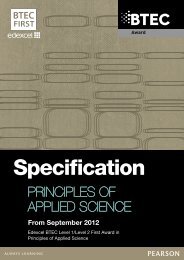BTEC First Award in Application of Science - specification - Edexcel
BTEC First Award in Application of Science - specification - Edexcel
BTEC First Award in Application of Science - specification - Edexcel
You also want an ePaper? Increase the reach of your titles
YUMPU automatically turns print PDFs into web optimized ePapers that Google loves.
UNIT 5: APPLICATIONS OF CHEMICAL SUBSTANCES<br />
Teacher guidance<br />
Resources<br />
The special resources required for this unit are a laboratory with at least one fume<br />
cupboard and samples <strong>of</strong> specialised materials.<br />
Assessment guidance<br />
This unit is assessed <strong>in</strong>ternally by the centre and externally verified by <strong>Edexcel</strong>.<br />
Please read this guidance <strong>in</strong> conjunction with Section 8 Internal assessment.<br />
The content <strong>of</strong> this unit should be approached from a practical po<strong>in</strong>t <strong>of</strong> view as<br />
far as possible, e.g. through scientific <strong>in</strong>vestigative assignments.<br />
Level 1 exemplifies partial achievement with<strong>in</strong> a level 2 learn<strong>in</strong>g aim.<br />
Learn<strong>in</strong>g aim A: Investigate and understand enthalpy changes associated<br />
with chemical reactions<br />
To achieve 1A.1, learners should carry out at least one exothermic and one<br />
endothermic reaction, measure the temperature changes and record these changes.<br />
Learners should correctly identify that the temperature <strong>in</strong>creased or decreased but<br />
do not need to make the l<strong>in</strong>k to the reaction tak<strong>in</strong>g <strong>in</strong> heat or giv<strong>in</strong>g out heat.<br />
A pr<strong>of</strong>orma could be used to allow learners to achieve this criterion. More<br />
understand<strong>in</strong>g is required at level 2.<br />
To achieve 2A.P1, learners should carry out two exothermic reactions and one<br />
endothermic reaction, and conclude, from the measurements <strong>of</strong> temperature change,<br />
that the reaction was exothermic (gave out heat) or endothermic (took <strong>in</strong> heat).<br />
They must understand the mean<strong>in</strong>gs <strong>of</strong> those terms.<br />
To achieve 2A.M1, learners must be able to expla<strong>in</strong> clearly the l<strong>in</strong>k between the sign<br />
<strong>of</strong> the temperature change and the heat absorbed by the water, <strong>in</strong> contact with the<br />
reaction (or <strong>in</strong>crease/decrease <strong>in</strong> temperature) and whether the reaction gives out<br />
heat or takes <strong>in</strong> heat. The words ‘exothermic’ and ‘endothermic’ should be used<br />
correctly. The role <strong>of</strong> the water <strong>in</strong> absorb<strong>in</strong>g heat or supply<strong>in</strong>g heat must be<br />
expla<strong>in</strong>ed.<br />
To achieve 2A.D1, learners must be able to calculate the heat absorbed by or taken<br />
from the water, <strong>in</strong> contact with the reaction us<strong>in</strong>g the equation mCΔT and relate this<br />
to the enthalpy changes for reactions <strong>in</strong> terms <strong>of</strong> break<strong>in</strong>g bonds (which requires<br />
heat) and mak<strong>in</strong>g bonds (which releases heat).<br />
Learn<strong>in</strong>g aim B: Investigate organic compounds used <strong>in</strong> society<br />
To achieve 1B.2, learners should research and identify the uses <strong>of</strong> crude oil fractions.<br />
They must specifically state the uses <strong>of</strong> the gases: propane and butane. This could be<br />
done by the preparation <strong>of</strong> a poster or by detailed labell<strong>in</strong>g <strong>of</strong> a fractional distillation<br />
diagram.<br />
To achieve 2B.P2, learners must show that they can describe how fractional<br />
distillation <strong>of</strong> crude oil works and be able to identify the uses <strong>of</strong> a range <strong>of</strong> the<br />
fractions. That could be done by produc<strong>in</strong>g an annotated diagram <strong>of</strong> a fractional<br />
distillation column. They must specifically state the uses <strong>of</strong> propane and butane,<br />
petrol, diesel and kerosene.<br />
To achieve 2B.M2, learners need to expla<strong>in</strong> the boil<strong>in</strong>g ranges <strong>of</strong> the different<br />
fractions to show how compounds are separated. This could be achieved by the use<br />
<strong>of</strong> secondary data such as a table or detailed annotation on a fractional distillation<br />
column diagram.<br />
BF029957 – Specification – <strong>Edexcel</strong> <strong>BTEC</strong> Level 1/Level 2 <strong>First</strong> <strong>Award</strong> <strong>in</strong> <strong>Application</strong> <strong>of</strong> <strong>Science</strong> –<br />
Issue 1 – March 2012 © Pearson Education Limited 2012<br />
45








